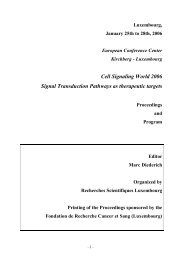Abstract book (download .pdf file) - Redox and Inflammation ...
Abstract book (download .pdf file) - Redox and Inflammation ...
Abstract book (download .pdf file) - Redox and Inflammation ...
You also want an ePaper? Increase the reach of your titles
YUMPU automatically turns print PDFs into web optimized ePapers that Google loves.
Session 1: Cell death Poster 15<br />
�<br />
ATP regulated Apoptosis versus Autophagy in Cultured Dendritic Cells.<br />
Sarah Flacke 1 , Patricia Schilling 1 , Fengguang Liu 1 , Karl J. Foehr 1 , Manfred Weiss, Paul<br />
Walther 2 , E. Marion Schneider 1<br />
1 Sektion Experimentelle Anaesthesiologie, University Hospital Ulm, Steinhoevelstr. 9, 89075<br />
Ulm, Germany; 2 Electron Microscopy Facility, Ulm University, Ulm, Germany<br />
Cell stress may lead to the release of nucleotides in many tissues. Specifically, fluid shear, cell<br />
stretching, hypoxia, osmotic swelling, but also temperature-related stimuli induce ATP release in<br />
addition to other nucleotides. Extracellular nucleotides bind to cell surface P2 receptors, either P2X,<br />
which are ATP-gated nonselective cation channels, or P2Y, which are G-protein-coupled receptors.<br />
There are seven subtypes of P2X (P2X1–7) <strong>and</strong> eight subtypes of P2Y (P2Y1, -2, -4, -6, <strong>and</strong> -11–14)<br />
receptors currently identified in mammals. A major effect occurs by ATP following stimulation of the<br />
P2RX7 receptor leading to extensive cell blebbing in addition to pore formation, facilitating the<br />
transport of molecules as large as 900 kD. Amongst cells of the hematopoietic system, macrophages<br />
<strong>and</strong> dendritic cells express P2RX7 receptors at high density. The expression of P2RX7 as well as its<br />
functional activity can be further increased by in vitro culture in the absence of exogenous growth<br />
factors <strong>and</strong> cytokines. Using cell biology methods, patch clamping, caspase 3/7 <strong>and</strong> caspase 8<br />
measurements in lysates, <strong>and</strong> or LC-3 staining by flow cytometry, we determined the effect of<br />
extracellular ATP on cultured dendritic cells from patients with macrophage activation syndromes<br />
(MAS). In contrast to healthy donors, MAS patients were unique by their increased precursor<br />
frequencies of P2RX7 high expressing dendritic cells in peripheral blood. We found two types of<br />
ATP- responses in selected donors: One which induced apoptosis following ATP-stimulation <strong>and</strong><br />
another mediated increased LC-3 expression <strong>and</strong> autophagy by the same ATP stimulation protocol.<br />
These differential results corresponded to a donor-specifically smaller (about 10pA/pF) or larger<br />
(about 100pA/pF) electrophysiological response as determined by patch clamping. Pyrosequencing<br />
was applied to study functional single nucleotide polymorphisms of the P2RX7 receptor in different<br />
donors. Out of 5 SNPs investigated*, the P2RX7 signal intensity as well as pro- vs. anti-apoptosis <strong>and</strong><br />
the corresponding induction of autophagy in these dendritic cells, was largely related to a 1513A!C<br />
polymorphism, responsible for a Glu496!Ala exchange in the intracellular C-terminus of the P2RX7<br />
receptor. We therefore conclude that functional SNPs of the P2RX7 receptor are responsible for<br />
dichotomous stress-induced <strong>and</strong> P2RX7-mediated response leading to either apoptosis or increased<br />
survival of immature dendritic cells. Moreover, this observation may explain a differential traumainduced<br />
stress response in vivo.<br />
*Geistlinger et al. Clin Chim Acta, in press.<br />
81




